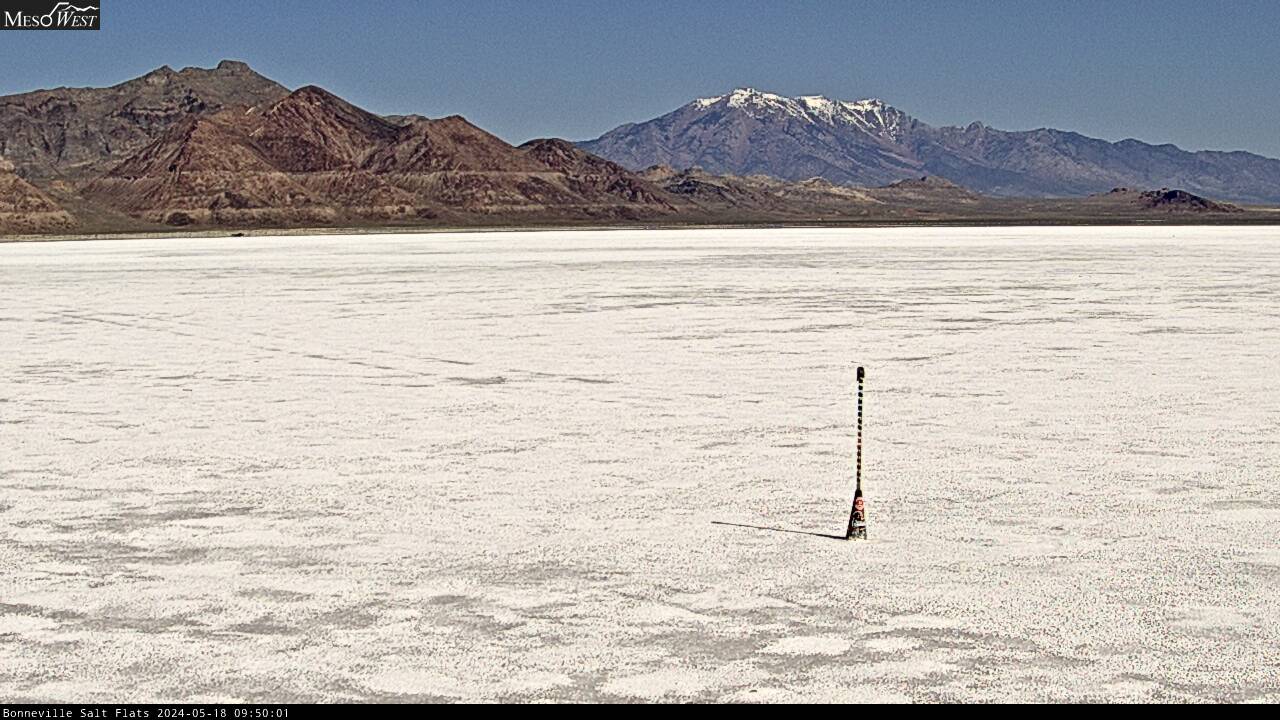Bonneville, UT Weather Cams
Bonneville Salt Flats Cam

Bonneville Salt Flats: Where Speed Meets Spectacle on a Natural Wonder of the West
Bonneville Utah Webcams. The Bonneville Salt Flats, a shimmering expanse of salt crust stretching across northwest Utah, is a landscape like no other. With its vast white plains and surreal beauty, the salt flats have captured the imagination of adventurers, artists, and speed enthusiasts for generations. From its ancient origins as a prehistoric lake to its modern-day status as a mecca for land speed racing, the Bonneville Salt Flats’ story is one of natural wonder, human ingenuity, and the pursuit of speed.
Geological Origins: A Prehistoric Lakebed
The history of the Bonneville Salt Flats begins millions of years ago during the Pleistocene Epoch, when much of western North America was covered by a vast inland sea known as Lake Bonneville. As the climate changed and the glaciers receded, Lake Bonneville began to shrink, leaving behind a series of smaller lakes and salt flats in its wake.
Over thousands of years, the remnants of Lake Bonneville gradually evaporated, leaving behind a thick layer of salt and other minerals deposited on the lakebed. The result was the vast expanse of white salt flats that we see today, stretching for over 30,000 acres across the Utah desert.
Native American Heritage: The Salt People
For thousands of years, Native American tribes, including the Shoshone, Ute, and Paiute peoples, inhabited the region surrounding the Bonneville Salt Flats. These indigenous peoples revered the salt flats as a sacred place and used the salt for a variety of purposes, including food preservation, trade, and ceremonial rituals.
The Shoshone people, in particular, have a strong connection to the salt flats, referring to themselves as the “Salt People” and considering the salt to be a sacred gift from the Earth. They harvested the salt from the flats using primitive tools and techniques, trading it with neighboring tribes for other goods and resources.
Early Exploration and Settlement
European exploration of the Bonneville Salt Flats began in the early 19th century with the arrival of fur trappers and explorers in search of new trade routes and resources. The salt flats were initially viewed as a barren wasteland, devoid of life and resources, and were largely avoided by early settlers.
In the late 19th and early 20th centuries, however, interest in the salt flats began to grow as pioneers and homesteaders ventured into the region in search of new opportunities. Some settlers attempted to mine the salt for commercial purposes, while others established ranches and farms on the fringes of the flats.
Land Speed Racing: The Quest for Speed
The Bonneville Salt Flats gained international fame in the early 20th century as a venue for land speed racing, attracting thrill-seekers and adrenaline junkies from around the world. In 1914, the first official speed trials were held on the salt flats, with daredevils racing customized cars and motorcycles across the flat, featureless expanse.
Over the years, the Bonneville Salt Flats became synonymous with speed and spectacle, hosting countless world-record attempts and setting the stage for some of the most iconic moments in motorsports history. The vast, open terrain of the salt flats provided the perfect testing ground for high-speed vehicles, with drivers pushing the limits of human and machine in pursuit of ever-faster speeds.
The Rise of the Bonneville Speedway
In 1949, the Bonneville Speedway was officially established on the salt flats, providing a dedicated venue for land speed racing and other motorsports events. The Speedway featured a 10-mile-long course with designated lanes for different types of vehicles, including cars, motorcycles, and even trucks.
The Bonneville Speedway quickly became a mecca for speed enthusiasts and racing aficionados, attracting competitors and spectators from around the world. Each year, during Speed Week and other racing events, the salt flats come alive with the roar of engines and the thrill of competition, as drivers compete for glory and the chance to etch their names into the annals of motorsports history.
Conservation and Preservation Efforts
Despite its popularity as a racing venue, the Bonneville Salt Flats have faced threats from development, mining, and environmental degradation in recent decades. The delicate salt crust that covers the flats is highly susceptible to damage from human activity, and efforts have been made to protect and preserve this unique natural wonder for future generations.
In the 1990s, the Bureau of Land Management designated the Bonneville Salt Flats as an Area of Critical Environmental Concern, recognizing its ecological significance and cultural value. Since then, conservation efforts have focused on restoring and maintaining the health of the salt flats, including measures to reduce erosion, control dust, and mitigate the impacts of racing activities.
The Future of the Salt Flats
As the Bonneville Salt Flats look to the future, they continue to attract visitors and adventurers from around the world, drawn by their otherworldly beauty and legendary status as a racing venue. Despite the challenges of conservation and preservation, the salt flats remain a symbol of human ingenuity and the enduring quest for speed.
In recent years, efforts have been made to revitalize the racing events at the Bonneville Speedway and ensure the long-term sustainability of motorsports activities on the salt flats. By balancing the needs of conservation with the demands of racing, stakeholders hope to preserve the legacy of the Bonneville Salt Flats for generations to come, ensuring that this unique natural wonder continues to inspire awe and wonder in all who visit its shimmering shores.
For more information, visit the official Alta Ski Area website.
